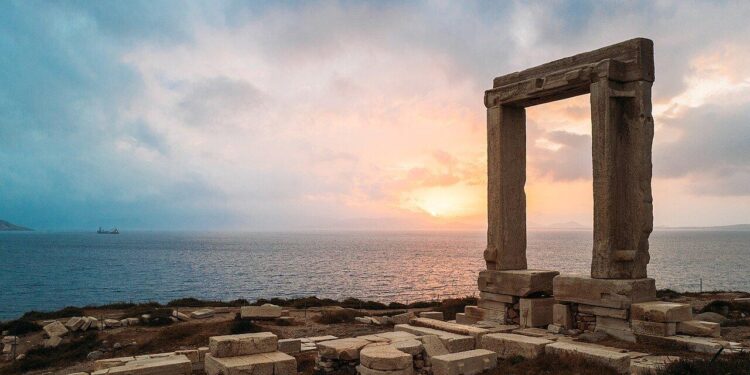Archaeologists have unveiled a remarkable discovery off the coast of Naxos, Greece, where a semi-submerged ancient settlement has come to light. The site, believed to date back several millennia, offers new insights into early Aegean civilizations and their adaptation to shifting sea levels. Researchers involved in the excavation emphasize the significance of this find for understanding the region’s historical landscape and maritime activities. This groundbreaking revelation, reported by GreekReporter.com, marks a major advancement in underwater archaeology in the Cyclades.
Researchers Uncover Semi-Submerged Ancient Settlement Off Naxos Coast
In a groundbreaking underwater excavation off the coast of Naxos, archaeologists have brought to light a rare semi-submerged settlement dating back to the early Bronze Age. The discovery showcases an intricate network of dwellings, communal spaces, and defensive structures, many partially submerged due to millennia of rising sea levels. Researchers emphasize that this finding provides crucial insights into ancient coastal living, revealing sophisticated urban planning and adaptation strategies unknown until now.
Key features identified at the site include:
- Stone-built foundations resilient to marine erosion
- Remnants of pottery and tools indicating a thriving local economy
- Evidence of early irrigation channels that hint at agricultural innovation
| Feature | Estimated Age | Significance |
|---|---|---|
| Dwellings | 3300-2900 BCE | Indicates permanent settlement patterns |
| Pottery Shards | Circa 3200 BCE | Shows advanced craftsmanship and trade links |
| Irrigation Channels | Approx. 3100 BCE | Evidence of agricultural sophistication |
Archaeological Insights Shed Light on Early Aegean Civilization and Maritime Practices
Recent underwater excavations off the coast of Naxos have uncovered a remarkable semi-submerged settlement dating back to the Early Bronze Age, providing unprecedented insights into the ingenuity of early Aegean societies. Submerged stone structures, alongside intact ceramic vessels and trade artifacts, reveal a thriving community skilled in maritime navigation and coastal resource management. The discovery challenges previous notions of early island habitation, indicating that these ancient peoples adapted swiftly to changing sea levels and exploited marine environments effectively.
Among the key findings are several types of artifacts highlighting both daily life and long-distance trade:
- Pottery shards: Displaying distinct regional styles, suggesting extensive exchange networks.
- Bronze tools: Indicative of advanced crafting techniques and maritime equipment.
- Anchors and fishing gear: Demonstrating sophisticated seafaring practices.
- Organic residues: Offering clues about diet and animal domestication.
| Artifact Type | Material | Estimated Age (years BCE) | Significance |
|---|---|---|---|
| Ceramic Storage Jar | Clay | 3200 | Trade & Storage |
| Stone Anchor | Granite | 3100 | Maritime Navigation |
| Bronze Knife | Bronze | 3150 | Crafting & Daily Use |
| Bone Fishing Hook | Bone | 3180 | Fishing Technology |
Experts Call for Enhanced Preservation Efforts Amidst Rising Sea Levels Impacting Site
Experts emphasize the urgency to bolster protective measures as sea levels continue to threaten the integrity of the ancient settlement recently discovered off the coast of Naxos. The partially submerged site, which dates back to the early Bronze Age, offers invaluable insights into maritime trade and regional interaction in the Aegean but faces severe erosion and saltwater damage. Archaeologists advocate for immediate interdisciplinary collaboration combining archaeological expertise, environmental science, and advanced engineering to safeguard this heritage before further degradation occurs.
Key recommendations for preservation focus on proactive strategies such as:
- Installation of underwater barriers to reduce wave impact and sediment displacement
- Regular monitoring using remote sensing technology for early detection of structural changes
- Community engagement and awareness programs to foster local stewardship
With rising sea levels accelerating, the window to implement these critical interventions is narrowing, making swift action crucial to preserve the cultural legacy beneath Naxos’s coastal waters.
| Preservation Action | Expected Benefit | Timeline |
|---|---|---|
| Underwater Barriers | Wave energy reduction | 6-12 months |
| Remote Sensing Monitoring | Early damage detection | Ongoing |
| Community Engagement | Local protection support | 3-6 months |
Closing Remarks
The discovery of the semi-submerged ancient settlement at Naxos offers a remarkable glimpse into Greece’s rich and layered history, shedding new light on early maritime communities in the Aegean Sea. As archaeologists continue to study the site, experts anticipate that further findings will deepen our understanding of ancient trade, architecture, and daily life. This groundbreaking revelation not only enriches the historical narrative of Naxos but also reinforces Greece’s status as a cradle of civilization, where past and present converge beneath the waves.
















